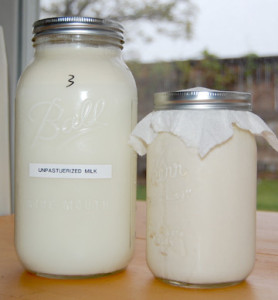Milk kefir: Milk that has been cultured (fermented) into a thick, creamy, tangy-sour, probiotic-filled smoothie.
Most people don’t know what milk kefir is, but with the growing movement towards whole foods and probiotics, kefir is coming into more public awareness. So much so, that it can now be bought in the dairy aisle of most grocery stores.
Lifeway (lifewaykefir.com) makes kefir in a variety of flavors and styles (low fat, whole milk, Greek, “green”), all containing pasteurized milk. My preference is for raw, unpasteurized milk because of all of the nutritional benefits (see my post on raw milk) that end up being killed by pasteurization. But you would have to culture your own raw milk in order to have raw milk kefir. If you are willing to make it yourself, it’s very easy. Continue reading



I really appreciated your story. Our horse was recently diagnosed with Strangles, but thankfully was not put on antibiotics. We let the strangles run its course and she was doing better for a few weeks. However, she may now have bastard strangles (we are waiting for test results to come back) as she is having other symptoms. She is on heavy duty antibiotics now, but I’m wondering if you remember what antibiotics were prescribed for your horse? I’m assuming the steroids were given for the swelling? If they served another purpose, I’d be interested to hear what that was. I want to do everything for our horse possible. Thank you for your time.
I don’t remember what the antibiotic was. When he was in quarantine they had him hooked up to an IV for a week. I don’t know about the steroids, but it seems they would have been included. Once he was back home we had to give him these huge antibiotic pills, 6 three times a day, for an entire month. My vet wanted to put him on some special super duper antibiotic that had to be specially ordered and costs about $1,000 per dose. We opted for the pills and he’s been fine ever since (it’s been 6 years). I did give him probiotics, knowing what antibiotics do to gut health. That was a tough summer. Hopefully you have really good vets, you’re close to horse country so I’m thinking you do. Best of luck to you and your horse!
Hi there,
Can you remember if he was exposed to strangles (either another horse or vaccine or from a horse that just got the intranasal vaccine where it would have come in contact with him, ) at any time? This would have started it all.
Also, do you remember what test it was that confirmed he was not contagious ? Thank you for this story, I am going thru this now, where the horse was misdiagnosed and we were told it was lymphangitis / cellulitis? She was put on 2 types of Antibiotics for 2 weeks. She is 27 and is having a super rough go, but she is still fighting. My theory is that when the owner purchased her (300-400 lbs underweight) 7 years ago, she had had strangles at some point. it Harbored in her and having Cushings (went untreated for a few years) came out. It is clearly now Bastard Strangles. Did you put Joe on any Nsaids? Dawn seems in pain, and when given Banamine she starts eating again and moving around. The Vet does not fully believe my theory…….. so frustrated!
Hi Pam, so sorry you’re going through this! Joe was given to me, he had been at the same stables for five years before that so he must have been exposed prior to that and was a carrier for years. But he never had full symptoms until his hock injury threw his body into overload. The vets, once they finally acknowledged that Joe had strangles, did some sort of test on (probably) nasal mucus which showed he was not a shedder. They didn’t tell me what the test was called. Other horses at the stables had been exposed to him for months while he was sick, some of them even cleaned his face for him, and none of them got sick.
I don’t recall Nsaids, but my guess is they would have given him some when he was on the IV antibiotics for a week. He was in terrible pain when he had stocked up. That all happened in 2013. I was just in touch with his current owner yesterday and they’re celebrating his 21st birthday! No problems since the situation I had, except for a little arthritis, but he’s still being ridden when he’s up to it. My vet was going to write a paper on Joe’s case because he and the other vets didn’t believe it either! I don’t know if he followed through, he’s retired now, but his name is Dale Rice and he’s in Elizabeth, CO. Best of luck to you and your horse. Maybe you can tell your vet about my experience? I don’t know if Dale is still around, but he’d probably talk to your vet if he is.
Update: https://threepeaksveterinary.com/ (303) 683-4634
thank you so much! this is helpful. It is a mystery but heartbreaking to see her go thru this. W might have to put her down, but every time we discuss it she perks up and we keep trying.
Thanks
Pam